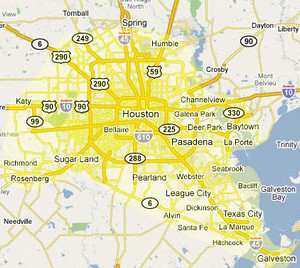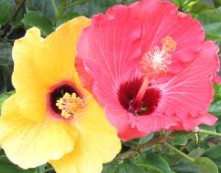Coastal areas are at a benefit for landscape design with their climate of being warmed in the winter and cooled in the summer by the water of the Gulf of Mexico.
Creating evergreen landscapes is simple, and very low maintenance, with proper evaluation of the soil and area, and choosing the best plants for the design.
 |
Coastal Winds Become a Factor
Careful consideration must be implemented of the prevailing winds location. Coastal areas have a prevailing wind that has a high salt content which can be very damaging to plants that are not native to the environment.
Generally, sites that face north or east will receive the greatest amounts of the sea spray. It’s important to periodically wash this salt layer off the plants, particularly in the drier months when there is limited rainfall to rise the plants.

Tender leafed plants such as hibiscus (pictured), bananas, and gingers are best kept sheltered from the wind and a southern exposure.
Plants aren’t the only thing that needs to be protected from the salt, though. Grass also need to be carefully chosen and fertilized regularly to help maintain its lushness. St Augustine and Bermuda grasses fare very well in coastal communities.
Soil Considerations
The soil in coastal communities can be sandy and enriching the soil with adequate amounts of pine bark, leaf mold, and aged manure.

If possible, mix these ingredients to a depth of 10 inches. Sandy soil tends to be very lose, so with any new plantings it’s advised to stake or guide the larger specimens.
Another soil type that is found within the communities is black clay gumbo (pictured). For this type of soil, the addition of gypsum, aged manure, leaf mold, pine bark and other organic materials is recommended.
In designing coastal area landscapes, be sure to only chose suitable salt tolerant species.
Aiming for a natural themed landscape with several curves will be easier to maintain and mow. For the vertical structure, palms such as sables, (Florida and Texas), Canary Island date palms, and Chinese fan palms will provide a lush tropical evergreen landscape.
If you would rather have standard trees in the landscape, opt for live oaks, wax lingstum, champhor, and crape myrtles. For shrubbery, species such as oleander, bottlebrush, wax ligustrum, althea, and green pittoporum are excellent choices. As mentioned previously, St Augustina and Bermuda grass are suitable ground covers, but in lieu of grass, there’s also Asian jasmine, purple honeysuckle, liriope, and monkey grass among others.
One of the most enjoyable aspects of landscape design is in choosing the flowering aspects of the yard.
There are a variety of vines and tropicals that will implement color and texture. Many species add fragrance as well as beauty, such as Jasmine. Some tropicals, however need to be protected from the elements as mentioned before; these are the hibiscus, copper, purslane, coleus, sultana, boganvelia, plumeria and allamanda.
If you are in extremely close proximity to the shore (i.e. within 30 feet), the best choices that have minimal salt spray damage are wax lingstum, lantana, honeysuckle, sedum, canna and oleander.

